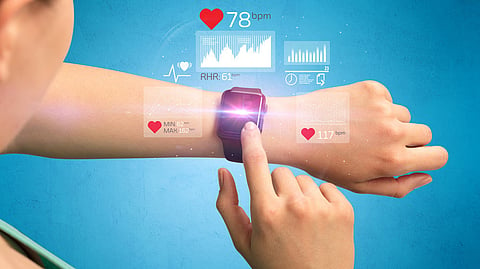
- Insights
- Cryptocurrencies
- Stocks
- White Papers
- Industry
- Geography
- Insights
- Cryptocurrencies
- Stocks
- White Papers
- Industry
- Geography


Health-centered wearables, from recognizable trackers like Fitbits to vibrating armlets that train wearers not to touch their faces, are seeing restored intrigue. In the wake of arriving at a twofold financing record in 2016 (when about $700M was invested across 110+ arrangements), wearable health tech startups have seen declining deals and sub-$550M yearly investment for a long time in succession.
On account of recent innovative advances, estimating real-world interactions by the utilization of cell phones and wearable sensors has gotten conceivable, permitting scientists to accumulate information on human social interactions in a variety of contexts with high spatial and worldly goals. Empirical data portraying contact networks have along these lines procured a significant level of detail that may yield new insights into the elements of contamination transmission between people.
Simultaneously, such information delivers new challenges identified with their statistical
depiction and analysis and to their utilization in mathematical models. Specifically, the integration of exceptional point by point exact information in computational structures intended to model the spread of infectious diseases raises the issue of surveying which portrayals of the crude information work best to inform the models.
The Scripps Research Translational Institute has launched an application based research program that will break down members' wearable health information including heart rates, sleep and activity levels with the objective of all the more rapidly detecting the development of flu, coronavirus and other fast-spreading viral illnesses.
Individuals from the public who are 18 or older and utilize a smartwatch or activity tracker, for example, a Fitbit, Apple Watch, Amazfit or Garmin Watch, can join the investigation and agree to share their information by downloading the MyDataHelps mobile application. By tackling key data points from these user's wearable gadgets, Scripps researchers accept they can improve real-time surveillance of contagious respiratory illnesses. Early discovery is basic for effective public health response to irresistible disease outbreaks and for improving medicines.
At any rate 1 out of 5 U.S. grown-ups utilize a mobile health application or wearable gadget, a pattern that cuts across about every single demographic group and is anticipated to proceed with its development in coming years. La Jolla, Calif.- based Scripps Research built up the application-based examination in an organization with CareEvolution, a health technology company.
"Considering the ongoing influenza season and the worldwide pandemic of COVID-19, we see a gigantic opportunity to upgrade disease tracking for improved population health," said Jennifer Radin, Ph.D., an epidemiologist at the Scripps Research Translational Institute, in a readied articulation. "One approach to do this is to use and break down the rich health information that is as of now being gathered by a huge number of Americans who normally utilize wearable gadgets."
The initial step was to model the effect of early virus detection through at-home diagnostics and wearable devices which empower prior sickness recognition and treatment and may urge individuals to make faster action and to look for faster treatment. At-home innovation could send alarms to individuals who are still pre-symptomatic and advise them if they are exposed to the flu, for instance; this alarm could be augmented by informing from local public health entities if there were an outbreak or pandemic in the community.
Exposure data could then be imparted to individuals' healthcare providers through current telemedicine capacities, and those providers could, therefore, recommend a flu antiviral that would be delivered by means of curbside drop-off or drone delivery. These advances are not cutting edge; they are as of now set up and they can empower individuals to get quicker treatment and to remain at home, which may decrease further transmission of the infection.
Vaccines and future immunization innovations were then applied to the model. Significant effort right now is dedicated to creating vaccine innovations, for example, utilizing recombinant-based advancements to speed up vaccine creation and investigating better approaches to circulate those vaccines. There is a lot of significance of putting resources into innovations that make vaccines accessible and of putting resources into the formation of community-level distribution channels that allow vaccines to be administered easily and rapidly—which, in turn, elicits the necessary immune response during an outbreak. At the point when new vaccines and vaccination technologies were added to the model, their synergistic interaction with early antiviral treatment depended on early detection and warning.
There is a developing need to find some kind of harmony between simplicity and detail so as to guarantee both generalizability and exactness of forecasts. It is crucial to audit recent work on the assortment and analysis of exceptional point by point information on temporal networks of face-to-face human proximity, carried out in the context of the SocioPatterns collaboration. There are different degrees of coarse-graining that can be utilized to represent the information so as to illuminate models regarding infectious disease transmission. Additionally, there are a few confinements of the information and future roads for data collection and modelling efforts in the field of infectious diseases.
